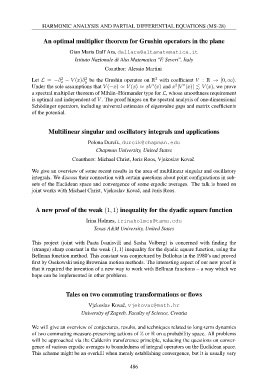Page 488 - 8th European Congress of Mathematics ∙ 20-26 June 2021 ∙ Portorož, Slovenia ∙ Book of Abstracts
P. 488
HARMONIC ANALYSIS AND PARTIAL DIFFERENTIAL EQUATIONS (MS-28)
An optimal multiplier theorem for Grushin operators in the plane
Gian Maria Dall’Ara, dallara@altamatematica.it
Istituto Nazionale di Alta Matematica "F. Severi", Italy
Coauthor: Alessio Martini
Let L = −∂x2 − V (x)∂y2 be the Grushin operator on R2 with coefficient V : R → [0, ∞).
Under the sole assumptions that V (−x) V (x) xV (x) and x2|V (x)| V (x), we prove
a spectral multiplier theorem of Mihlin–Hörmander type for L, whose smoothness requirement
is optimal and independent of V . The proof hinges on the spectral analysis of one-dimensional
Schödinger operators, including universal estimates of eigenvalue gaps and matrix coefficients
of the potential.
Multilinear singular and oscillatory integrals and applications
Polona Durcik, durcik@chapman.edu
Chapman University, United States
Coauthors: Michael Christ, Joris Roos, Vjekoslav Kovacˇ
We give an overview of some recent results in the area of multilinear singular and oscillatory
integrals. We discuss their connection with certain questions about point configurations in sub-
sets of the Euclidean space and convergence of some ergodic averages. The talk is based on
joint works with Michael Christ, Vjekoslav Kovacˇ, and Joris Roos.
A new proof of the weak (1, 1) inequality for the dyadic square function
Irina Holmes, irinaholmes@tamu.edu
Texas A&M University, United States
This project (joint with Paata Ivanisvili and Sasha Volberg) is concerned with finding the
(strange) sharp constant in the weak (1, 1) inequality for the dyadic square function, using the
Bellman function method. This constant was conjectured by Bollobas in the 1980’s and proved
first by Osekowski using Brownian motion methods. The interesting aspect of our new proof is
that it required the invention of a new way to work with Bellman functions – a way which we
hope can be implemented in other problems.
Tales on two commuting transformations or flows
Vjekoslav Kovacˇ, vjekovac@math.hr
University of Zagreb, Faculty of Science, Croatia
We will give an overview of conjectures, results, and techniques related to long-term dynamics
of two commuting measure-preserving actions of Z or R on a probability space. All problems
will be approached via the Calderón transference principle, reducing the questions on conver-
gence of various ergodic averages to boundedness of integral operators on the Euclidean space.
This scheme might be an overkill when merely establishing convergence, but it is usually very
486
An optimal multiplier theorem for Grushin operators in the plane
Gian Maria Dall’Ara, dallara@altamatematica.it
Istituto Nazionale di Alta Matematica "F. Severi", Italy
Coauthor: Alessio Martini
Let L = −∂x2 − V (x)∂y2 be the Grushin operator on R2 with coefficient V : R → [0, ∞).
Under the sole assumptions that V (−x) V (x) xV (x) and x2|V (x)| V (x), we prove
a spectral multiplier theorem of Mihlin–Hörmander type for L, whose smoothness requirement
is optimal and independent of V . The proof hinges on the spectral analysis of one-dimensional
Schödinger operators, including universal estimates of eigenvalue gaps and matrix coefficients
of the potential.
Multilinear singular and oscillatory integrals and applications
Polona Durcik, durcik@chapman.edu
Chapman University, United States
Coauthors: Michael Christ, Joris Roos, Vjekoslav Kovacˇ
We give an overview of some recent results in the area of multilinear singular and oscillatory
integrals. We discuss their connection with certain questions about point configurations in sub-
sets of the Euclidean space and convergence of some ergodic averages. The talk is based on
joint works with Michael Christ, Vjekoslav Kovacˇ, and Joris Roos.
A new proof of the weak (1, 1) inequality for the dyadic square function
Irina Holmes, irinaholmes@tamu.edu
Texas A&M University, United States
This project (joint with Paata Ivanisvili and Sasha Volberg) is concerned with finding the
(strange) sharp constant in the weak (1, 1) inequality for the dyadic square function, using the
Bellman function method. This constant was conjectured by Bollobas in the 1980’s and proved
first by Osekowski using Brownian motion methods. The interesting aspect of our new proof is
that it required the invention of a new way to work with Bellman functions – a way which we
hope can be implemented in other problems.
Tales on two commuting transformations or flows
Vjekoslav Kovacˇ, vjekovac@math.hr
University of Zagreb, Faculty of Science, Croatia
We will give an overview of conjectures, results, and techniques related to long-term dynamics
of two commuting measure-preserving actions of Z or R on a probability space. All problems
will be approached via the Calderón transference principle, reducing the questions on conver-
gence of various ergodic averages to boundedness of integral operators on the Euclidean space.
This scheme might be an overkill when merely establishing convergence, but it is usually very
486


